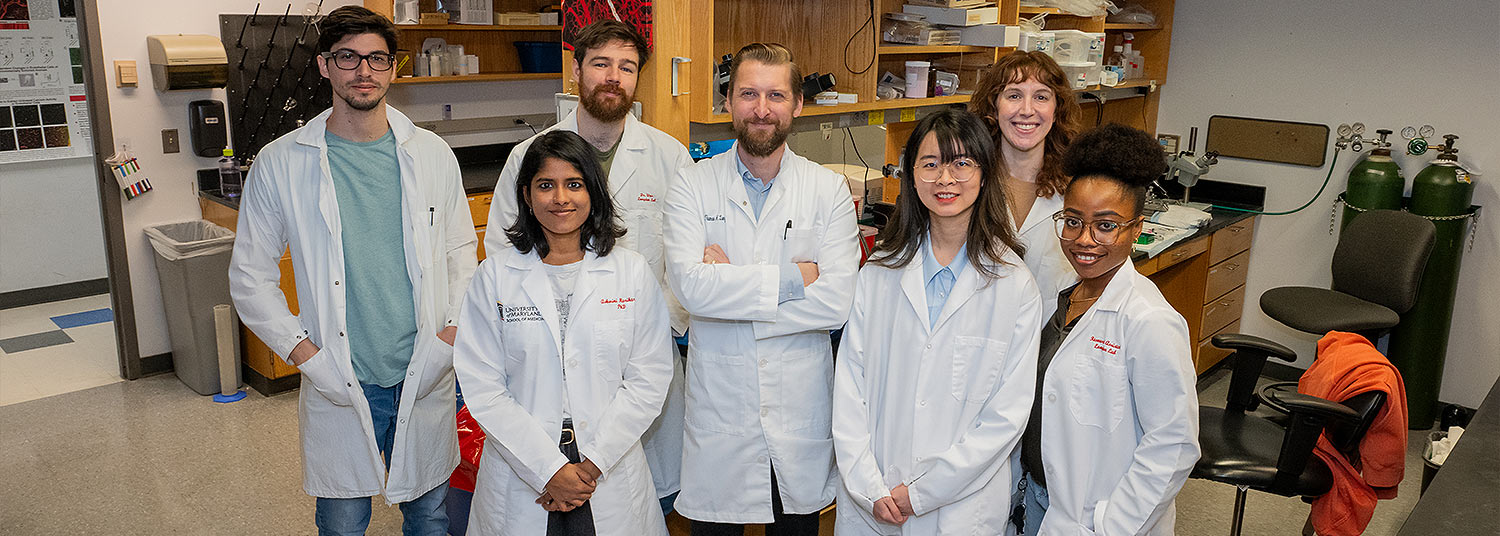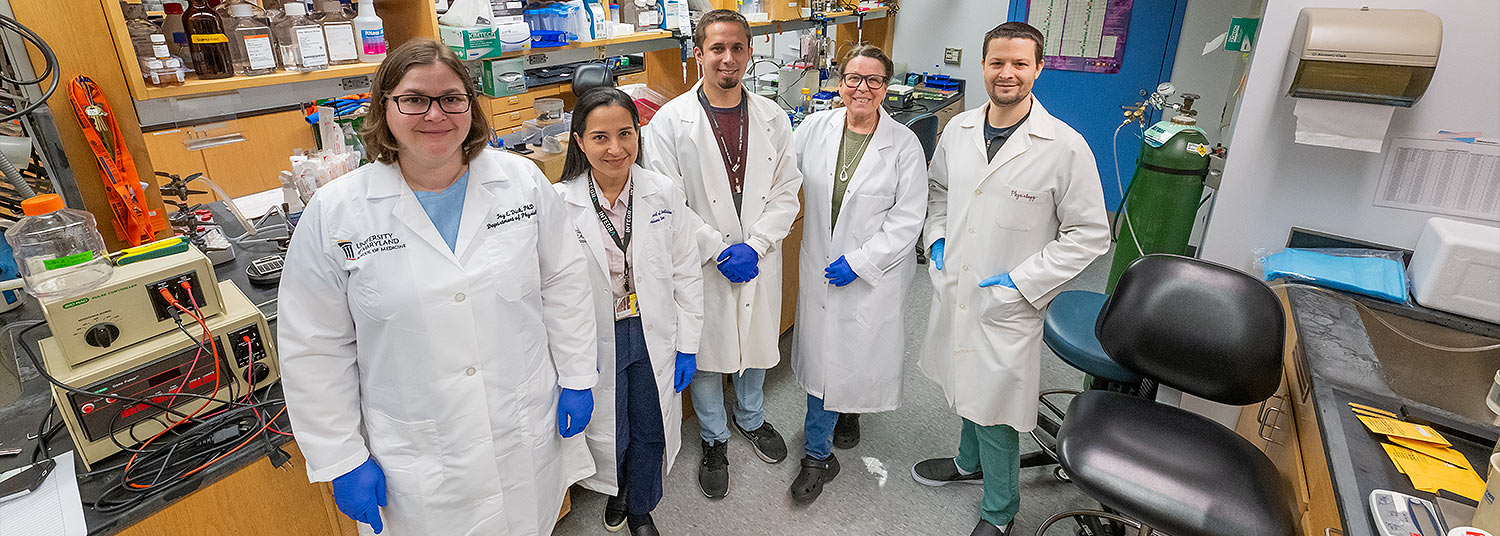
Fang Lab
The Fang lab investigates the ubiquitin-proteasome system and ER-associated degradation (ERAD) pathway, particularly how ERAD dysfunction and the unfolded protein response (UPR) contribute to diseases. Our current research is primarily centered on ER proteostasis-targeted drug discovery, in collaboration with scientists at the National Center for Advancing Translational Sciences (NCATS). We are developing several classes of small molecules targeting ERAD regulators, with the potential to become first-in-class drugs to address unmet medical needs in conditions such as VEXAS syndrome, autoimmune diseases, COPD, obesity, and neurodegenerative diseases such as Alzheimer's and amyotrophic lateral sclerosis.
- Shengyun Fang, PhD, Principal Investigator

Ferrer Lab
The Ferrer Lab at the University of Maryland Baltimore and the Greenebaum Comprehensive Cancer Center studies the ability of cancer cells to initiate, disseminate and metastasize. Our mission is to advance the understanding of metastatic pancreatic cancer and develop new therapeutic strategies to improve patient outcomes.
- Christina Ferrer, PhD, Principal Investigator
- Visit the Ferrer Lab >

Garg Lab
The Garg Lab studies pathways that affect mitochondrial bioenergetics, focusing on the ion channels and transporters within mitochondrial membranes and how their dysfunction contributes to human disease. Mitochondria play a crucial role in ATP production, metabolism, redox homeostasis, and calcium signaling. Mitochondrial abnormalities underlie many diseases, including cancer, heart failure, myopathies, neurodevelopmental disorders, and age-related conditions. We also explore how organisms adapt to mitochondrial defects, such as inborn errors in metabolism and bioenergetics. Our goal is to uncover mechanisms fundamental to mitochondrial physiology that could lead to the development of novel therapeutic strategies for combating these diseases.
- Vivek Garg, PhD, Principal Investigator
- Visit the Garg Lab >

Hamlyn Lab
My lab investigates modulators of active sodium transport in the cardiovascular, adrenal, CNS and renal arenas in health and disease. In the CNS, we use chromatography and mass spectrometry to map related key chemical entities that alter the long-term activity of networks that govern behavior and executive functions. We also use radiolabeled precursors to explore biosynthetic pathways for key chemical entities. The goal is to generate a comprehensive map of the brain in health and disease that is based specifically upon key chemical regulators. In the periphery, we participate in a phase 4 clinical trial that tests the role of sodium transport modulation as a way to prevent surgery-evoked acute kidney injury.
- John Hamlyn, PhD, Principal Investigator

Longden Lab
The Longden lab studies the complexities of neurovascular interactions and energy delivery in the brain. We focus on understanding multiple aspects of brain physiology, from the biological mechanisms that regulate how blood flows throughout the vascular network in health, to the mechanisms by which blood flow is disrupted in dementias.
- Thomas A. Longden, PhD, Principal Investigator
- Visit the Longden Lab >

Martin Lab
The Martin lab focuses on identifying molecular mechanisms that enable metastatic breast tumor cells to travel through non-adherent environments, such as the bloodstream or lymphatics. Our previous work identified unique microtentacles on the surface of circulating breast tumor cells that promote reattachment in distant tissues. Combining bioengineering and tumor cell biology, we investigate mechanisms regulating microtentacles, apoptosis and mechanotransduction in epithelial tumor cells to help identify new therapies to reduce metastasis.
- Stuart Martin, PhD, Principal Investigator
- Visit the Martin Lab >

Mathur Lab
The primary focus of the lab is to understand how neural macro- and microcircuits control action learning and selection under normal and pathophysiological conditions. We combine neuroanatomical methods with genetic, optogenetic, in vivo calcium imaging, animal behavior, and slice electrophysiology to define both neural circuit form and function. We employ mouse models of alcohol use disorder to determine how specific neural circuits are affected by pathological states with a focus on restoring normal circuit function and, therefore, behavior.
- Brian Mathur, PhD, Principal Investigator
- Visit the Mathur Lab >

McCarthy Lab
The research laboratory of Margaret McCarthy, PhD, aims to understand the origins and mechanisms of sex differences in the brain. Sexual differentiation of the brain is a developmental process whereby physiological and behavioral phenotypes are modified to match gonadal phenotype to ensure reproductive success.
- Margaret McCarthy, PhD, Principal Investigator
- Visit the McCarthy Lab >

Meredith Lab
Our mission in the Meredith Lab is to understand the biophysical basis of electrical coding over multiple biological timescales using multi-disciplinary methods from patch-clamp electrophysiology to CRISPR gene-edited transgenic models and patient-derived tissues. In the brain's circadian clock, our studies have identified an integrated suite of biophysical mechanisms used by a central type of ion channel that impart state-dependent control over cellular excitability. We also led the translational and clinical characterization of a new neurogenetic epilepsy and dyskinesia disorder (KCNMA1 channelopathy). Our studies reveal how rhythmic excitable signals are encoded, and the neurological disorders that result when these signals malfunction.
- Andrea Meredith, PhD, Principal Investigator
- Visit the Meredith Lab >

Mong Lab
A primary focus of my research is the study of mechanisms underlying the ovarian steroid control of sleep and arousal systems. Our laboratory uses a multidisciplinary approach, which combines behavioral, cellular, and molecular and functional neuroanatomical techniques.
- Jessica A. Mong, PhD, Principal Investigator

Njar Lab
Dr. Vincent C. O. Njar has a long-standing interest in the rational discovery and development of small molecules as anti-cancer agents. The major objective of his current research is to design, synthesize, and evaluate novel patentable compounds in suitable model systems with potentials to prevent and/or treat breast and prostate cancers. Dr. Njar is also interested in understanding mechanisms of anti-cancer actions of the novel agents.
- Vincent C. O. Njar, PhD, Principal Investigator
- Visit the Njar Lab >

Poulopoulos Lab
The goal of our group is to understand the in vivo mechanisms that determine circuit formation in development and circuit remodeling in adulthood; to discover how these processes deviate to alter brain circuits in neurodevelopmental conditions and mental illness; and to develop the knowhow and methodologies that may allow therapeutic intervention for the regeneration of circuits lost to disease or trauma.
- Alexandros Poulopoulos, PhD, Principal Investigator
- Visit the Poulopoulos Lab >

Qiu Lab
The Qiu Laboratory studies molecular mechanisms underlying therapeutic resistance in prostate cancer, with focus on understanding the functions of protein kinases (SRC, ETK/BMX and PIM-1), nuclear receptor (androgen receptor and its splicing variants), and ubiquitin E3 ligase (RNF6).
- Yun Qiu, PhD, Principal Investigator

Su Lab
The Su Laboratory studies the development and function of the human immune system and human liver, and HIV-1/HCV infection and immuno-pathogenesis.
- Humanized mouse models to study human hamatopoietic stem cells (HSC), thymus and liver stem cells.
- FoxP3 and regulatory T (Treg) cells in viral infection and immuno-pathogenesis.
- Modeling immuno-pathogenesis and immuno-therapy of chronic HIV and HCV.
- Lishan Su, PhD, Principal Investigator

Sun Lab
The Sun Lab studies molecular mechanisms that repair DNA damage induced by topoisomerase inhibitors, by poly(ADP-ribose) polymerase (PARP) inhibitors, and by crosslinking agents such as reactive aldehydes. The goal of their research is to target these DNA repair mechanisms to improve tumor response to topoisomerase inhibitors and to PARP inhibitors. In addition, the Sun Lab studies topoisomerase biology by conducting genome-wide CRISPR screening to identify and characterize genes/mechanisms that compensate for the loss of topoisomerases in human cells.
- Yilun Sun, PhD, Principal Investigator
- Visit the Sun Lab >

Vogel Lab
Age-related Macular Degeneration (AMD) is a common human disease that is characterized by progressive degeneration of sensory neurons, called photoreceptors, in the retina. Currently, we are studying how interactions between complement factor H (a secreted protein that is frequently mutated in AMD patients), transmembrane, and cytoskeletal proteins affect sensory neuron function in C. elegans, asking whether these interactions are conserved in vertebrate photoreceptors, and exploring the implications of our findings in patients that are at high risk for AMD.
- Bruce E. Vogel, PhD, Principal Investigator

Wolff Lab
The Wolff Lab studies how distributed neuronal networks underlie complex learning processes, using motor skill learning in rats as our model.
- Steffen B.E. Wolff, PhD, Principal Investigator
- Visit the Wolff Lab >

Woodward Lab
The Woodward laboratory focuses on the complicated workings of the human kidney, using the power of human genetics to decipher the role of transporters and ion channels in renal function and human disease. The primary projects in the lab center around the role of metabolite transport in altering kidney function, and the role for ion channels in regulating tubular morphology in polycystic kidney disease.
- Owen M. Woodward, PhD, Principal Investigator
- Visit the Woodward Lab >

Yu Lab
Our lab researches the mechanism of cancer metastasis, the major cause of cancer-related death. Distant metastasis is mostly initiated by tumor cells shed from the primary tumor into the blood circulation, known as circulating tumor cells (CTCs), which are carried to distant organs where metastatic tumors eventually arise. By studying CTCs isolated from breast cancer patients and mouse models, using approaches of molecular and cellular biology, single cell tracing, and modeling in animals, we strive to gain a better understanding of the metastasis-initiating properties in CTCs and obtain novel insights on how to target those rare populations.
- Min Yu, PhD, Principal Investigator
- Visit the Yu Lab >






